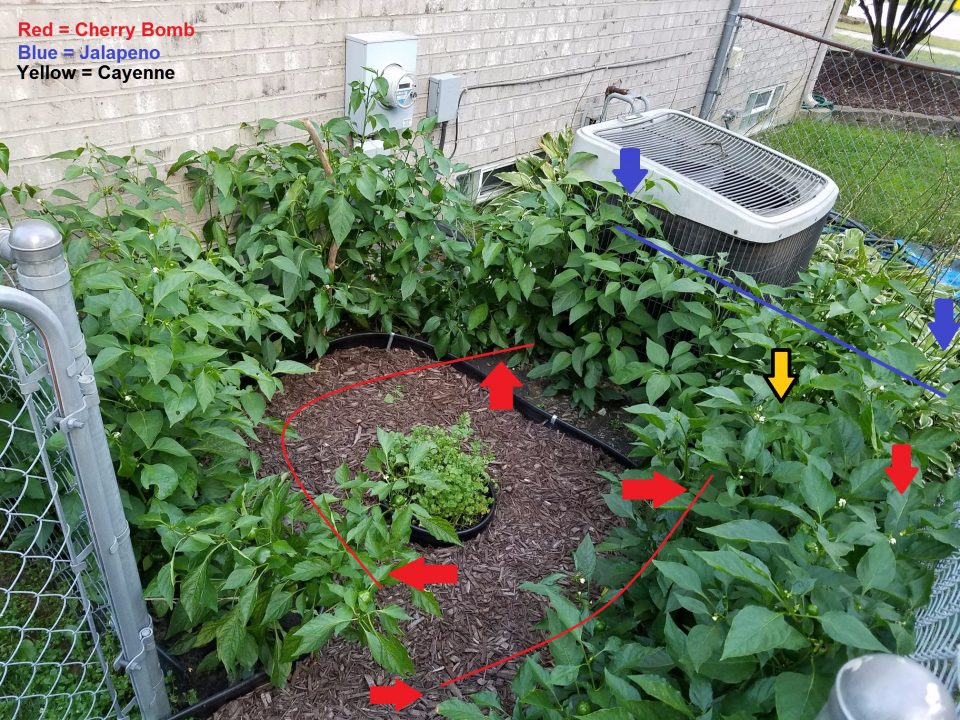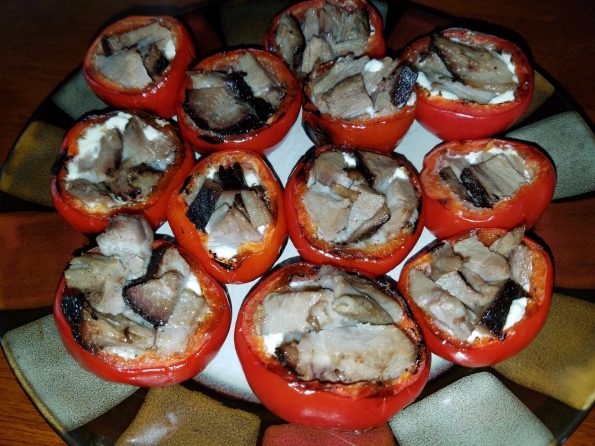Cross Pollinating Peppers

Have you ever wanted to try your hand at cross pollinating peppers? Maybe this hasn’t crossed your mind (pun intended). But it’s a real possibility.
If you grow peppers in your own garden, this might have already happened to you on accident. Especially if you grew them close together. In fact, it happened to me this year.

My Experience This Year - 2017
In this picture you can see 2 very different looking peppers… on the exact same plant. There’s been a bumble bee enjoying all the flowers in the small pepper area I planted.
This never even crossed my mind when planning out the garden this year. Even though I’ve had experience in the past where planting hot peppers close to not-so-hot ones caused them to be on fire.
In fact, when I started this particular plant (and the ones surrounding it) from seed, I thought they were Scotch Bonnets which are pretty hot. They would’ve been the hottest in the whole bed.
Turns out they were Cherry Bomb peppers. Next to them went Jalapenos, then one Cayenne, and finally several more Cherry Bombs… because I didn’t think I would have any and wanted a bunch.
The Entire Pepper Bed

As you can see in this picture, everything was planted in very close proximity to each other. I think the distance was at most 16 or 18 inches between each plant. That’s not very far. These were planted this way because I knew how good this area was for growing from last year and I wanted to maximize capacity.
For gardeners planning to save their own pepper seeds for next year, it is recommended to separate different varieties of peppers by 50 feet. For farmers the distance is much greater. As far as mile.
Of course this is if you don’t want cross pollinated peppers. If you do, then doing what I’ve done above can definitely help with cross pollinating peppers naturally. All you’ll need is the help of some pollinators. Or you can do it yourself.
How Cross Pollination Works
This picture explains how it happens in nature via pollenators such as bees. As mentioned above, I believe a bumble bee is responsible for cross pollination in my pepper bed. I have seen him multiple times in this area.
Bees can easily fly long distances. That is why it is encouraged to grow plants you *don’t* want cross pollinated far apart. This can reduce the chances that the bee with pollen from one plant won’t fly to another.
Pepper plants are actually self pollinating. They don’t need the help of bees. A gentle breeze that rustles the plant is all they need.
Actually, if you’re having problems with your peppers not germinating you can simply tap on the plant, or use an electric toothbrush, near open flowers to get things going.
What if you wanted to do this on your own?

Cross pollinating peppers on your own really isn’t that difficult. But you will need to be careful how you do it. Otherwise the process will fail. Rather than try to explain it in text, I’ve found a great video explanation:
Saving Seeds for Next Year
If you watched the video you probably heard him say that you will not see the traits from cross pollinating peppers until you’ve planted the next generation. Well in my experience, this isn’t completely true.
Now, it may be that the next generation of plants that comes from these seeds is very different from what is pictured. If that’s the case, I can’t wait to see.
At the time of writing this I still haven’t tasted these large peppers yet. They are just now turning ripe. My parents are coming in town soon so I would like to wait on trying them until they’re here if possible.
Now let’s discuss how to properly save cross pollinated seeds for next season.

Best Practices for Saving Seeds
Saving pepper seeds is incredibly simple. All you have to do is collect peppers from your best producing plant. Wait until the peppers are ripe, maybe even a little wrinkly. Many peppers will turn red when they ripen, as you can see in the picture.
Harvest the pepper(s) and cut off the back end. Depending on the size of the pepper, you can core out the white part from the inside the same way you would if making Jalapeno Poppers.
If that won’t work or the pepper is too small, then gently slice long ways through one wall (don’t split the whole pepper in half) all the way to the end and peel it in half to expose the seeds.
Then gently remove all the seeds from the placenta (white part). Spread them out and allow them to dry for a few days.

Storing Seeds
Keeping your seeds for next year is also simple. Just store them in a labeled paper envelope. Keep them in a cool, dry place like your spice cabinet or something.
If you really want to get serious you can use some seed packets. They could come in very handy for saving and organizing seeds from many varieties of plants.
I have used a paper plate in the past which got shuffled around the house. Yeah, my wife didn’t like that too much. Save yourself the trouble!
One last thing: it is advisable to use your seeds within one year. After that they become less likely to germinate.
My Plans and Hopes

The peppers in this picture are stuffed Cherry Bombs. I cut off the stem ends, cut out the seeds and grilled them topside down for a few minutes. Then I brought them inside and stuffed them with cream cheese and smoked pork before putting them back on the grill to finish off. Talk about fantastic!
My plans are to save the seeds from the cross pollenated peppers above and plant them next year to see what happens. They are similar in shape to the Jalapenos that they were crossed with, but much bigger around. Meaning they can be stuffed with so many more goodies.
If, and I mean IF they come out similar to this year, I will attempt to save all the seeds I can. Depending on how many I have, I will probably try to give them away. We’re talking end of next year (2018) or early Spring 2019.
As always, I hope you enjoyed this article and learned something new. Sign up to our mailing list for updates and tips from Grow To Save!

He is correct in the video, the peppers will not present the traits from the cross pollination until next generation. If you have had peppers that were not characteristic of the pepper plant you planted, it was because of an error at the seed producer (pretty common, actually), either the seed was mislabeled or was the result of cross pollination itself. The pepper (fruit) is like the womb of the mother plant, it contains the traits of the parent plants from the previous season. The seeds are the offspring and are the result of the cross pollination that occurs within the season that the pepper grew. The seeds will contain the genetic traits from the two plants cross pollinated within the current season but the pepper will have traits from the previous season’s pollination, as the pepper is an extension (like a body part) of the mother plant and her genes. It can be a tricky concept but this has been the easier way I have found to explain it to others
Also, as I watched the video, i realized his method to cross two varietals of peppers would also work well if you’d like to preventing cross pollination but still grow different varietals of peppers in close proximity. I don’t save seeds from some plants because of this but now I have a method that will allow me to save seeds and keep the true characteristics of that varietal of pepper.
Another fun pepper fact, pepper plants are perennial so if you bring them indoors to overwinter, they can be planted out in spring, after risk of frost has passed, to give it a good head start. I do this for peppers that I only grow one or two of each.
Hi Cindy, thanks for the comments! I have tried overwintering a few times indoors here in MI and they’ve always managed to die right before spring… Frustrating! As for saving seeds, I’ve had mixed results. Last year (2019) there were some 15-17 plants total and only a few of them produced the desired shape that happened from the first cross pollenation. Everything else, though the same seed stock, came in a wide variety of shapes. I only save seeds from the desired shape peppers. This year, 2020, all of my early plant starts died from aphids by time to harden off that were brought in from one of last year’s plants I tried to overwinter, which also died. Finally direct sowed seeds in early June and they’re just now starting to fruit in September. Haven’t determined what these peppers will look like though, fruit isn’t big enough yet.